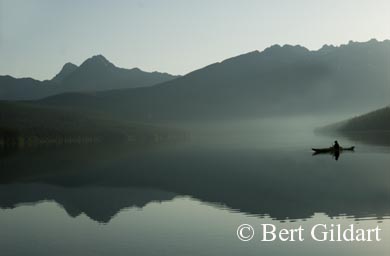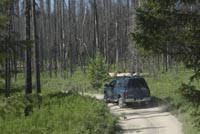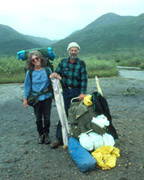The Tranquility of Kintla Lake
SEARCHING FOR PHOTOS AND PROSE
With Kayaks, Mountain bikes, Backpacks, Daypacks, Walking Sticks, Fishing Poles—and an Airstream Travel Trailer
 Bert Gildart: Kintla Lake, located in the most extreme northwestern portion of Glacier National Park, is probably the most remote lake in the park that can still be accessed by a vehicle. The last 15 miles of the road, however, is bumpy, narrow and windy. In places you have to check overhead clearance, particularly if you are toting kayaks as were we.
Bert Gildart: Kintla Lake, located in the most extreme northwestern portion of Glacier National Park, is probably the most remote lake in the park that can still be accessed by a vehicle. The last 15 miles of the road, however, is bumpy, narrow and windy. In places you have to check overhead clearance, particularly if you are toting kayaks as were we.
In 1965, while in college, I worked there as a seasonal ranger, and know that days when the lake is perfectly tranquil are rare. But that’s precisely what we’ve enjoyed these past two days.
In the ’60s power boats were allowed, but that’s not the case today, and that makes it a haven for those interested in kayaking. Each morning we arose early, and each morning we tried to improve on the reflection picture of the previous day, realizing, finally, that the human element might add an extra dimension. Positioning, however, had to be precise, and that meant lots of hand signals between Janie and me so as not to disturb other campers still asleep. The results paid off, and Janie’s presence added to the reflection of Starvation Ridge and Starvation Peak (in Canada) and Long Knife Peak (still in the United State on far right) reflecting in this lake located about five miles from the Canadian line.
 Since I worked at Kintla, more has been learned about the area. Once Indians used the lake’s shore, and because archaeologists found a Folsom point near the campground, digging—even of trenches around tents—is not permitted. Size restrictions have also been placed on the types of RVs that can use the area, and that is not only to create a more wilderness type atmosphere, but to help protect RV units themselves. Trailers over 19 feet are not permitted, meaning that when we visit the area we do so with a tent (our Airstream is 28 feet long).
Since I worked at Kintla, more has been learned about the area. Once Indians used the lake’s shore, and because archaeologists found a Folsom point near the campground, digging—even of trenches around tents—is not permitted. Size restrictions have also been placed on the types of RVs that can use the area, and that is not only to create a more wilderness type atmosphere, but to help protect RV units themselves. Trailers over 19 feet are not permitted, meaning that when we visit the area we do so with a tent (our Airstream is 28 feet long).
For a variety of reasons, Kintla will always be one of our favorite places in Glacier, certainly because of its beauty, but perhaps as well, because it is such an ideal place to kayak and reasonably expect to see moose, bears and fox along the shores of the lake. That’s what we’ve seen over the years and predict that you will too.

